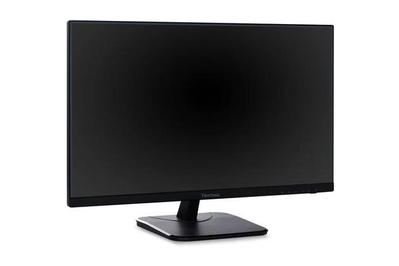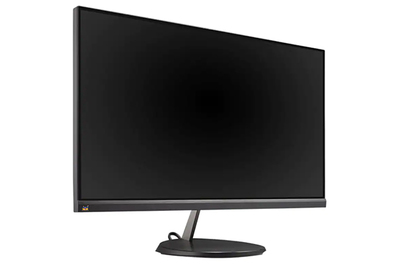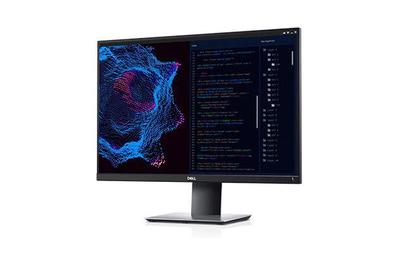Benq Gw2480 24 Inch Ips 1080p Monitor Review
The enquiry
- Why you should trust us
- Who this is for
- How we picked and tested
- Our option: ViewSonic VA2456-MHD
- Runner-up: ViewSonic VX2485-MHU
- Upgrade pick: Dell P2421
- The contest
- Footnotes
Why y'all should trust us
I've been testing, reviewing, and otherwise writing near PCs and other gadgets for AnandTech, Ars Technica, and Wirecutter since 2012. I've been building, upgrading, and fixing PCs for 2 decades, and five of those years were spent in It departments buying and repairing concern laptops and desktops as well as helping people purchase the best tech for their needs.
Our monitor guides benefit from the expert advice of Wirecutter senior staff writer Chris Heinonen—AnandTech's one-time monitor guru and the guy a number of other reviewers go to for display-testing communication. He helped us figure out the best hardware and software to use for our testing, and he designed the evaluation process.
Who this is for
The chief reason to buy a 24-inch monitor in 2020 is to save money—monitors 27 inches and larger, especially 4K models, tin price anywhere from two to v times as much equally a 24-inch 1080p monitor. But 24-inch screens also don't cost much more than 21- or 22-inch monitors, despite being noticeably larger. That'southward the main reason we focus on this screen size and resolution in our guide to the best upkeep monitors, and why many of the picks in that guide are featured in this one. These monitors aren't ideally suited to professional photo and video editing work, but they have improve image quality than a cheap laptop screen or the years-onetime monitor that came with the last desktop computer you bought, and yous can get a good one for $100 to $150.
Only a 24-inch monitor is also a solid choice if you're working with limited desk-bound space and just don't have room for a 27-inch monitor. If you lot can spend a bit more money, we recommend i other type of 24-inch monitor that can help you make the most efficient use of that infinite.

Monitors with a 1920×1200-pixel resolution give you 120 more vertical pixels than a 1080p monitor, making the screen slightly taller only giving yous enough extra room to view a few actress rows in a spreadsheet, or to read another paragraph in a document or commodity without scrolling.
Mostly, you can't find new 24-inch monitors with a 4K resolution (or 3840×2160 pixels). For those, you'll need to footstep up to the 27- and 32-inch models nosotros recommend in our guide to 4K monitors. The higher resolution can display sharper text and more detailed images, and y'all can make the moving-picture show larger or smaller without losing particular or making things wait blurry or overly pixelated.
How we picked and tested
Size and resolution aside, there are a lot of factors that determine whether a monitor is pleasant to look at and whether it volition meet your particular needs. When we research monitors, we're looking for the following:
- Size and resolution: We focus on 24-inch monitors because they're bigger than any laptop display, only they're cheaper than a 27-inch monitor and take up less space. At this size, 1080p resolution (1920×1080 pixels) will look reasonably sharp, and text and images should be large enough for most people to encounter without straining their eyes. If you're willing to spend more, taller monitors with a 1920×1200-pixel resolution can provide more than usable screen space without an increase in footprint.
- Display technology: Look for monitors that utilise IPS (in-plane switching) display panels, not TN (twisted nematic) panels. TN panels are cheaper, but not past much, and IPS panels offer better viewing angles and color reproduction.
- Ports: At a minimum, a monitor should take an HDMI connection or DisplayPort for connecting to a computer; ideally, a monitor will have both. Budget 24-inch monitors usually likewise include an old-school analog VGA port. If a monitor includes a USB-C port that tin receive a video signal from a laptop and provide ability to it at the same time, that's a bonus. Built-in USB hubs for connecting keyboards, mice, webcams, and other accessories are likewise nice to have.
- Price: Adept 24-inch 1080p monitors generally cost $100 to $150. Taller 1920×1200 monitors usually cost between $200 and $300.
- Stands and VESA mount support: For cheaper monitors, a stand up that can tilt the monitor up and down without wobbling too much is the all-time y'all can promise for. More expensive models include stands that tin can also swivel, raise and lower the monitor's acme, and pivot xc degrees into portrait style. All the monitors we recommend across Wirecutter support VESA mounts, if you desire to hang them on your wall or use a separate monitor arm.
- Contrast ratio: We measured each monitor'southward contrast ratio, the departure between the brightest white and the darkest blackness that the screen can display. A dissimilarity ratio of thou:1 or higher (notation that higher is better) is typical of the IPS panels nosotros recommend, which makes the dark areas of a screen easier to see when you're watching a movie or playing a game. Having a skillful contrast ratio is a lilliputian more important than having accurate color—you can often prepare inaccurate colour afterwards the fact by calibrating the monitor yourself, but a poor dissimilarity ratio is harder to address.
- Color accuracy: For any kind of photo, video, or graphics work, a monitor's color accurateness ensures that your images look the style you lot intend them to when they appear on some other screen or in print. More expensive monitors sometimes come calibrated from the factory to ensure more consistent and authentic color; budget monitors typically don't. Most people don't need perfect color accurateness, simply it should be practiced plenty that photos from your phone or movies you download don't look weird.
- Warranty: The monitors we recommend all include three-year warranties instead of the one-year warranties more typical for laptops and other consumer electronics. We also pay attending to each manufacturer's expressionless pixel policy—the number of vivid or "stuck" pixels and the number of dark pixels that a monitor needs to accept before the manufacturer volition repair or replace it.
- Loftier refresh rates and variable refresh rates: A loftier-refresh-rate monitor is one that tin refresh the contents of its screen faster than the typical sixty times per second (also called 60 Hz). Variable-refresh-rate monitors (also called adaptive sync) can friction match the monitor's refresh rate to the frame rate of a game you're playing, making gameplay smoother and eliminating screen tearing. The most common adaptive sync engineering is FreeSync, which works with nearly recent AMD and Nvidia graphics cards and doesn't add much to a monitor'south cost. We don't consider either of these features essential for a 24-inch monitor, but if you plan to play games they can be nice to have.
To examination those monitors, nosotros used each model for typical desktop work for a few hours, noting the sturdiness and quality of the stand and how like shooting fish in a barrel the monitor was to conform using the on-screen controls. Nosotros test for some mutual issues that can afflict LCD monitors, like low-light flicker (also called PWM flicker) and image retention.
We then tested the accuracy of each monitor's color—a screen with likewise-bright, oversaturated colour might expect adept to the naked heart, but if it isn't representing colors accurately, photos, videos, and web pages won't look the style their creators intended. We tested each monitor using an Ten-Rite i1Basic Pro and an X-Rite OEM i1Display colorimeter, equally well equally custom tests in the Calman software calibration suite designed by Wirecutter senior staff writer Chris Heinonen. The Calman tests produce DeltaE 2000 numbers, which bear witness how much the displayed color deviates from what information technology'due south supposed to be: the lower the number, the better the issue. A DeltaE value less than i.0 is perfect. Under 2.0 is adept enough for print-production work, and yous wouldn't notice a departure if you had a perfect reference to compare against. Ratings above 3.0 mean you'd probably run into a difference with your naked centre.
Color gamut, or the range of colors that a device tin can accurately represent, is also of import—color accuracy doesn't mean much if your screen shows just a portion of the colors meant to exist displayed—so nosotros used our Calman tests to determine how much of the sRGB color gamut each monitor's screen could reproduce. The platonic score is 100%. Our numbers don't go past that because reporting numbers larger than 100% can give the impression of full gamut coverage even in cases where that isn't true—for example, if the monitor displays many colors outside the gamut without displaying all the ones inside information technology. More expensive monitors and laptop screens sometimes support a wider color gamut chosen DCI-P3, but you won't find budget monitors that brandish all of those colors.
For each round of tests, nosotros adjusted the monitor's brightness to 140 cd/m2 (candelas per square meter), a proficient value for everyday utilise, and set its contrast as loftier every bit information technology could go without losing white details. We tested different born color presets for the monitors that had them, noting the ones that produced the most accurate colors.
Our pick: ViewSonic VA2456-MHD

Our pick

ViewSonic VA2456-MHD
Best 24-inch monitor
The VA2456-MHD has a reasonably color-accurate screen with expert contrast, DisplayPort and HDMI inputs, and decent-sounding internal speakers. Its stand up tin simply tilt upwardly and downwards, but that'south fine for the toll.
The ViewSonic VA2456-MHD is a 24-inch 1080p monitor with an IPS screen that offers a swell contrast ratio with detailed blacks, plus reasonably accurate color. It has HDMI, DisplayPort, and VGA ports, so y'all tin can connect only about any computer to it, and the stand isn't too wobbly or cheap-feeling. And the monitor includes okay-sounding internal speakers and a iii-twelvemonth warranty.
The VA2456-MHD is also our pick in our guide to upkeep monitors, which has more details and other options for similarly priced displays. Equally a budget monitor, it doesn't include many extras. There'due south no USB-C port or USB hub here, the stand can simply tilt the monitor upwards and down a few degrees, and it doesn't back up refresh rates higher than threescore Hz or FreeSync. But if yous just desire a decent external monitor for a laptop or desktop, it handles all the basics well.
Runner-upward: ViewSonic VX2485-MHU

Runner-upward

ViewSonic VX2485-MHU
Nifty for saving space
It costs a scrap more money than our pick, but the ViewSonic VX2485-MHU has a USB-C port that tin can charge near 13-inch laptops, which can save space by eliminating extra chargers and cables from your desk setup.
The ViewSonic VX2485-MHU costs more than the VA2456-MHD, and its color and contrast aren't quite as good. But this is one of the cheapest monitors yous get with a USB-C port, which can replace both your laptop's power brick and an HDMI or DisplayPort cable, saving you valuable space on your desk if you accept a cramped setup. The monitor can provide upwards to sixty W of ability to a laptop, which is good enough for nearly 13-inch laptops (including the MacBook Air and Pro and the Dell XPS 13) and other laptops without powerful dedicated graphics chips.
We get into greater item most the VX2485-MHU in our guide to budget monitors, but the short version is that there aren't many reasons to buy this over the cheaper VA2456-MHD if you lot plan to utilise it with a desktop PC or don't intendance nearly USB-C. Its stand swivels the screen from side to side but is otherwise like, and the warranties are the same. The VX2485-MHU does support a 75 Hz refresh rate and FreeSync, so it might merit a second look if you play games, just other budget monitors similar the Acer CB242Y bir offer those features for less money.
Upgrade pick: Dell P2421

Upgrade choice

Dell P2421
More usable screen space
The Dell P2421 has a taller aspect ratio than our other picks, which ways information technology offers extra vertical space that's useful when scrolling through big spreadsheets or long web pages and documents.
Ownership Options
*At the time of publishing, the price was $240 .
A few 24-inch monitors still utilise a 1920×1200-pixel resolution, an actress 120 vertical pixels that our 1080p picks don't accept. That means it will take up most the aforementioned corporeality of infinite on your desk as a 1080p monitor but requite you some actress room for scrolling through big spreadsheets or long documents. Dell's P2421 is the all-time of these taller 24-inch monitors, because it has lots of useful ports and a USB hub, expert color and contrast, a flexible stand, and a bang-up three-year warranty with a good dead-pixel policy. It commonly costs well-nigh $100 more than the ViewSonic VA2456-MHD, only it'due south a big stride upwards in almost every respect.
The P2421 is missing a USB-C port, but it has just about every other kind of monitor port that has ever existed—one DisplayPort, one HDMI port, a DVI port, and a VGA port. If you connect your figurer to the monitor's USB Blazon-B port, it enables the ii USB 2.0 ports on the back (ideal for mice, keyboards, and webcams) and the two USB iii.0 ports on the side (improve for flash drives and hard drives that benefit from extra speed).
Dissimilar our main pick'due south basic tilt-only stand, the P2421's stand tin tilt, swivel, raise and lower the monitor, and pivot it 90 degrees into portrait style. If you're not using the VESA mounting compatibility to hang the monitor on a wall or installing your own monitor arm, this is the best kind of stand you lot can become with a computer monitor, and it makes the P2421 flexible enough to fit into all kinds of desk setups.
The 1067:1 contrast ratio on the P2421 doesn't set any records and can't quite match the ViewSonic VA2456-MHD's, but information technology's typical for well-nigh computer monitors. Its color accuracy is besides expert but not not bad, and roughly on a par with the ViewSonic'southward.1 It's accurate enough that images and webpages volition await more or less like their creators intended them to, which is all that most people need.
Three-yr warranties are standard for all the monitors we recommend, but the P2421 too comes with Dell'south Premium Panel Guarantee. Dell volition repair or supplant your monitor if it has even one brilliant-subpixel defect—a dot on the monitor that stays bright white no matter what you're looking at. Well-nigh warranties will tolerate ii or 3 of these before they'll replace the monitor. Yet, Dell volition tolerate up to v dark-subpixel defects earlier it will supersede your monitor.
The P2421 is from Dell's business-oriented Professional product line, and then it doesn't support extra features similar high refresh rates or FreeSync. Games volition benefit from the monitor's extra screen space but like any other app would. But if you care more nigh smooth, super-responsive gameplay, the P2421 might not be the best choice.
The competition
sixteen:10 monitors
The Asus ProArt PA248QV is about every bit good equally the Dell P2421 on paper, and it commonly costs less. Information technology is missing a DVI port simply has all the other display inputs and a four-port USB hub. Its stand is every bit flexible, it also has a 3-year warranty, and when using its sRGB preset its colour accurateness is actually pretty good (though the brightness isn't adjustable in this mode). Just nosotros observed some faint image retention in our testing. If that doesn't bother you, the PA248QV is the cheapest otherwise decent 1920×1200 monitor you can buy right now.
The Dell UltraSharp U2415 was our previous top pick in this guide, and while information technology's an older model, it'southward extremely similar to the P2421 overall. They expect pretty like, their stands are functionally identical, and they accept the aforementioned warranty. Its ports differ slightly—it has one additional USB three.0 port, and trades the DVI and VGA ports for i boosted HDMI connector, a mini DisplayPort input, and a DisplayPort output. The U2415 is also usually a little more expensive than the P2421, its dissimilarity ratio isn't quite as good, and because information technology'southward older it's a little heavier and uses a bit more power. If you tin discover it for less than the P2421, though, it's still a skilful choice.
HP'south Z24n G2 was a previous runner-upwards pick in this guide, and information technology'due south the merely 16:x monitor nosotros tested to include a USB Type-C port. However, that port can only provide upwardly to 15 Westward of power to a connected device, which is far curt of what you need to charge most thirteen-inch laptops. This means information technology doesn't save you the space or the cables that make about USB-C monitors easy to recommend. It's as well the well-nigh expensive of the xvi:10 monitors nosotros tested.
Dell'due south U2412M is a pick from a much older version of this guide, but Dell still sells it for effectually the same price as the P2421 or the U2415. Even if it were cheaper, though, it would be hard to recommend in 2020—information technology doesn't have an HDMI input, all of its USB ports use USB two.0 instead of USB three.0, and it's much larger and heavier than the P2421, which might make it harder to clasp onto a cramped desk-bound.
Nosotros didn't test Lenovo'south ThinkVision T24d-10. It meets all of our requirements for a skillful 24-inch monitor, including a USB hub and all of the display inputs we typically wait for, and it usually costs nearly the aforementioned as or a little less than the Dell P2421. It'south just harder to find at most retailers, and it's got a chunkier stand up that adds nigh 4 inches to its depth compared with the P2421 (10.three inches versus 6.five). This makes it a hard sell if you're buying a 24-inch monitor mainly to salvage space.
4K monitors
About companies have stopped making new 24-inch 4K monitors, but we did test the LG 24UD58-B against the Dell P2415Q in 2019. The LG's screen was less authentic than the Dell's by a wide margin. This model also has fewer ports (two HDMI ports and one DisplayPort connexion), its stand can only tilt the monitor up and down, and like all of LG'southward consumer monitors its warranty lasts merely one year.
Footnotes
yarbroughtherignin.blogspot.com
Source: https://www.nytimes.com/wirecutter/reviews/best-24-inch-monitor/
Post a Comment for "Benq Gw2480 24 Inch Ips 1080p Monitor Review"